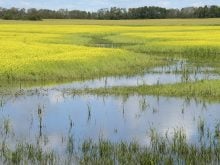The Axten family’s operation was first in the country to join a program that recognizes regenerative agriculture practices
Derek and Tannis Axten of Axten Family Farms in Saskatchewan became trailblazers in 2023.
They were the first in Canada to take a gamble on Regenified, a new program meant to assess and verify farms for their regenerative management practices.
But while the farm now has an official acknowledgement of their regenerative production, its a style they’ve been pursuing for over a decade and a half.
Read Also

Russian wheat exports start to pick up the pace
Russia has had a slow start for its 2025-26 wheat export program, but the pace is starting to pick up and that is a bearish factor for prices.
Derek Axten traced their regenerative interest back to 2006, when he and his wife visited the Dakota Lakes Research Farm in South Dakota.
“(We were) just trying to find ways to do things better than we were currently,” he said.
The research farm had been experimenting with soil conservation since the 1980s and was highlighting practices like no-till and diverse crop rotation.
The approach resonated with the Axtens, leading to a series of visits and collaborations that shifted the farm’s practices. They also met a now famous name in regenerative agriculture — North Dakota farmer, author and regenerative pioneer Gabe Brown.
“When we met Gabe and kind of saw what he was doing and had been doing and really seeing the outcomes on his farm, it was clear to us that we needed to make more changes,” Axten said.
The Axtens began attending conferences on soil health. After meeting Elaine Ingham, an American microbiologist, Tannis enrolled in Ingham’s soil food web courses.
The Axtens adopted the motto “soil to the soul” and every farming decision prioritized the soil ecosystem.
“Everything we do, we really think about, ‘how is this going to affect the soil ecosystem?’ Because everything we do is not beneficial for the soil, but if we have to do something detrimental, what can we do to give back, to restore it?” Tannis Axten said.
Her husband experienced what he calls a paradigm shift when he observed the differences between well-managed native grasslands and conventional agricultural soil.
“Fertilizer gives you more stuff, but it just depends on what your goals are. And for us, a lot of our goals were about trying to restore function and trying to restore organic matter, water infiltration, and holding capacity,” he noted.
The farm’s priorities eventually led them to Regenified.
The Axtens appreciated the program’s aim for continuous improvement, with farms assessed on a five-level scale depending on the proportion of the farm verified to be managed regeneratively.
They weren’t totally sold on the idea of a regenerative label, but the Axtens recognized the value of third-party verification.
“By having a third party come and verify that we’re doing what we say we’re doing, and measuring our outcomes to show that we really are improving our soil health, that’s kind of what hooked me,” Tannis said.
Becoming regen-ag certified isn’t a yes-or-no exercise, noted the program’s chief executive officer and co-founder, Shalar Shemirani. “This is ‘show me the evidence. Show me the proof. Show me. Show me the results. Show me the data.’”
The certification also complements organic farming, Shemirani said.
“We also want to see a system that is regenerative and organic.”
The Regenified co-founder added that farmers stand to benefit from new marketing opportunities and improved supply chain resilience.
“We hope that through regenerative farming and regenerative agriculture, we can increase the traceability and transparency across our food production system and also help more farmers to find the great benefits of regenerative agriculture is offering them, or could potentially offer them,” he said.
















